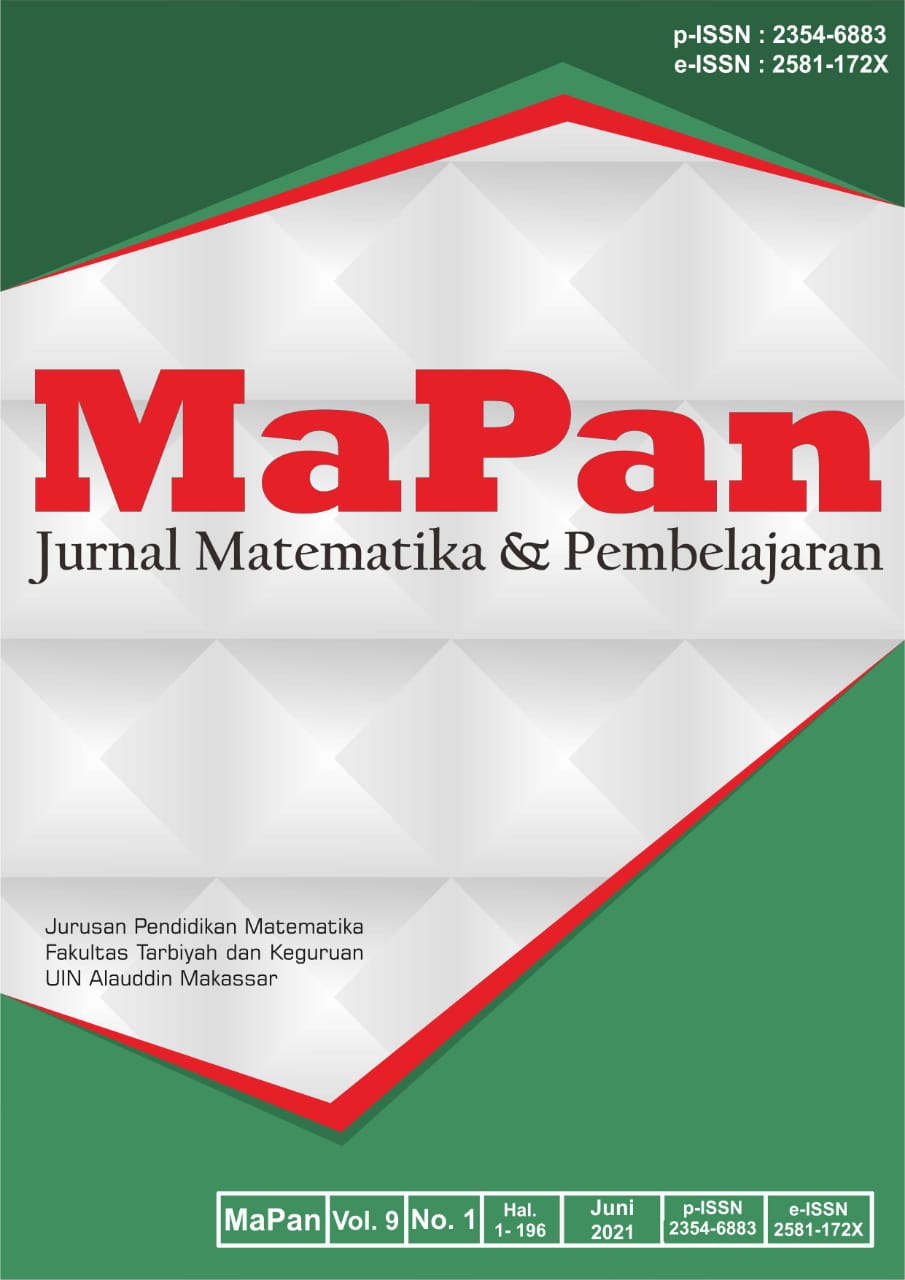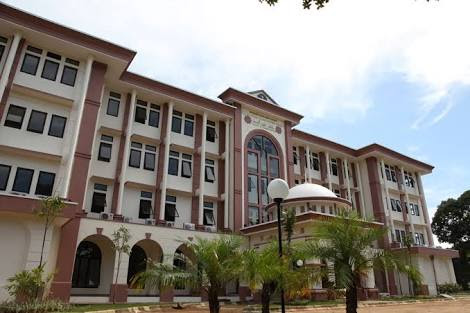USING GRAPHIC CALCULATOR IN TRIGONOMETRIC LEARNING: A DIDACTICAL DESIGN FOR TEACHER
Abstract
This study explored the activitiesusing a graphing calculator of 10th-grade high school students on the trigonometry topic. A total of 65 students were divided into two classes, the first class consisted of 32 students, and the second class consisted of 33 students. The main objective of this study is to present classroom activities enriched with graphing calculators and observe responses about teaching with this approach. This study is research on developing learning designs within the Didactical Design Research (DDR) framework presented in an exploratory narrative. Data were collected by using two trigonometry worksheets and lesson observations. The worksheets were constructed based on the following focus areas: behaviour of graphs, constructing related-angle formula, and overall performance of the learner. The result of this research is a learning design that has been tested on 65 high school students. The research results on how to analyze the results of the implementation of structured learning designs provide information that educators can use, including the use of graphing calculators to help and make it easier for students to identify graphs more quickly and make students accustomed to using trigonometric function symbols. Another finding from structured instructional designs is that working in groups allows students to share experiences more effectively.
Downloads
References
Barnes, A., Lawson, M., Geer, R., Sweeney, T., & White, B. (2011). Using learning technologies to support learning and teaching. Australia: Adelaide.
Blackett, N., & Tall, D. (1991). Gender and the versatile learning of trigonometry using computer software. In The Proceeding of the International Group for the Psychology of Mathematics Education XV, 1. pp. 144–151. Assisi, Itlay.
Challenger, M. (2009). From triangles to a concept : a phenomenographic study of A-level students' development of the concept of trigonometry. Unpublished. University of Warwick.
Curri, E. (2012). Using computer technology in teaching and learning mathematics in an albanian upper secondary school. Unpublished. University of Agder.
DeJarnette, A. F. (2014). Students' conceptions of trigonometric functions and positioning practices during pair work with Etoys. ProQuest Dissertations and Theses. University of Illinois at Urbana-Champaign.
Dundar, S. (2015). Mathematics teacher-candidates' performance in solving problems with different representation styles : the trigonometry example. Eurasia Journal of Mathematics, Science and Technology Education, 11(6), 1379–1397. https://doi.org/10.12973/eurasia.2015.1396a.
Ebert, D. (2014). Graphing projects with desmos. The Mathematics Teacher, 108(5), 388–391. https://doi.org/10.5951/mathteacher.108.5.0388.
Egan, K. (2005). An imaginative approach to teaching. San Francisco: Jossey-Bass.
Kagenyi, D. G. (2016). Pedagogical factors affecting the learning of trigonometry in secondary schools in gatundu north sub-county. Unpublished. Kenyatta University.
Kamber, D., & Takaci, D. (2017). On problematic aspects in learning trigonometry. International Journal of Mathematical Education in Science and Technology, 5211(August), 1–15. https://doi.org/10.1080/0020739X.2017.1357846.
King, A. (2017). Using desmos to draw in mathematics. Australian Mathematics Teacher, 73(2), 33–37. Retrieved from Retrieved from https://files.eric.ed. gov/fulltext/EJ1146898.pdf.
Liang, S. (2016). Teaching the concept of limit by using conceptual conflict strategy and desmos graphing calculator. International Journal of Research in Education and Science (IJRES), 2(1), 35–48. Retrieved from Retrieved from https://files.eric.ed.gov/fulltext/EJ1105103.pdf.
Maharaj, A., & Wagh, V. (2016). Formulating tasks to develop HOTS for first-year calculus based on Brookhart abilities. South African Journal of Science, 112(11–12), 1–7. https://doi.org/10.17159/sajs.2016/20160139.
Maknun, C. L. (2018). Rethinking technology integration in mathematics education. International Journal of Sciences: Basic and Applied Research, 37(3), 279–289. Retrieved from http://gssrr.org/index.php?journal= JournalOfBasicAndApplied&page=article&op=view&path%5B%5D=8864&path%5B%5D=3972.
Maknun, C. L., Rosjanuardi, R., & Jupri, A. (2018). Lesson design on the relationship between radian and degree. In AIP Conference Proceeding 2014, 020031 (2018), pp. 020031-1-020031–020038. Surakarta: AIP Publishing. https://doi.org/10.1063/1.5054435.
Maknun, C. L., Rosjanuardi, R., & Jupri, A. (2019). From ratios of right triangle to unit circle: An introduction to trigonometric functions. In Journal of Physics: Conference Series, 1157. https://doi.org/10.1088/1742-6596/1157/2/022124.
Maknun, C. L., Rosjanuardi, R., & Jupri, A. (2020). Didactical Design on Drawing and Analysing Trigonometric Functions Graph through a Unit Circle Approach. International Electronic Journal of Mathematics Education, 15(3). https://doi.org/https://doi.org/10.29333/iejme/9275.
Man, Y., & Poon, K. (2014). Exploring the limits of trigonometric functions: results and reflections from a pilot study. International Journal of Mathematical Education in Science and Technology, 45(2), 214–226. https://doi.org/10.1080/0020739X.2013.822577.
Marchi, D. J. (2012). A study of student understanding of the sine function through representations and the process and object perspectives. Ohio State University. Retrieved from https://etd.ohiolink.edu/!etd.send_file?accession=osu 1343253667&disposition=inline.
Mitchelmore, M., & Cavanagh, M. (2000). Students' difficulties in operating graphics calculator. Mathematics Education Research Journal, 12(3), 254–268. https://doi.org/10.1007/BF03217088.
Morobe, N. (2000). Lesotho pre-service teachers' understanding of function and the effect of instruction with a graphing calculator on pre-service teachers' understanding of function. Unpublished Doctoral Dissertation. University of Iowa.
Mosese, N. M. (2017). Evaluating The effectiveness of the use of information and communication technology in the teaching and learning of trigonometry functions in grade 12. Unpublished. University of South Africa.
Naidoo, J., Govender, R., Africa, S., Africa, S., Naidoo, J., & Africa, S. (2014). Exploring the use of a dynamic online software program in the teaching and learning of trigonometric graphs. Pythagoras, 35(2). https://doi.org/10.4102/pythagoras.v35i2.260.
Papageorgiou, E., & Christou, C. (2007). Investigating the processing structures of students' inductive reasoning in mathematics. Proceedings of the Fifth Congress of the European Society for Research in Mathematics Education, 4, 466–475.
Rohmah, R. N., Utomo, D. P., & Zukhrufurrohmah. (2019). The effectiveness of implementation warmer apperception to construct the conceptual understanding ob the learning material of vector. Mathematics Education Journal, 3(2), 159–167. https://doi.org/10.22219/mej.v3i2.11073.
Sugiyono. (2016). Metode penelitian pendidikan: pendekatan kuantitatif, kualitatif, dan R & D. Bandung: Alfabeta.
Suryadi, D. (2010). Penelitian pembelajaran matematika untuk pembentukan karakter bangsa. Prosiding Seminar Nasional Matematika Dan Pendidikan Matematika, pp. 1–14. Yogyakarta: Universitas Negeri Yogyakarta.
Trouche, L. (2005). Calculator in Mathematics Education: A Rapid Evolution of Tools, with Differential Effects. In D. Guin, K. Ruthven, & L. Trouche (Eds.), The Didactical Challenge of Symbolic Calculators: Turning a Computational Device into a Mathematical Instrument, pp. 9–39. Boston: Springer.
Tuna, A. (2013). A Conceptual Analysis of the Knowledge of Prospective Mathematics Teachers about Degree and Radian. World Journal of Education, 3(4), 1–9. https://doi.org/10.5430/wje.v3n4p1.
Copyright (c) 2021 Churun Lu’lu’il Maknun, Rizky Rosjanuardi, Al Jupri

This work is licensed under a Creative Commons Attribution 4.0 International License.


